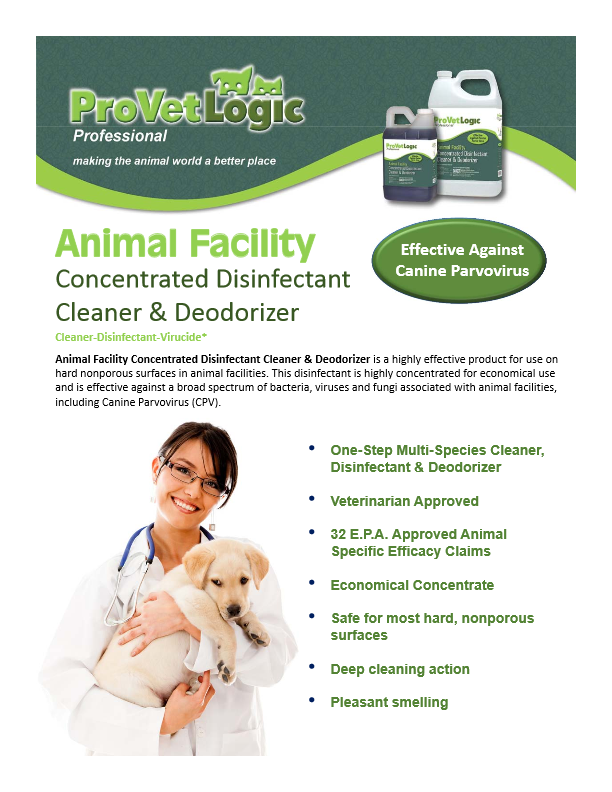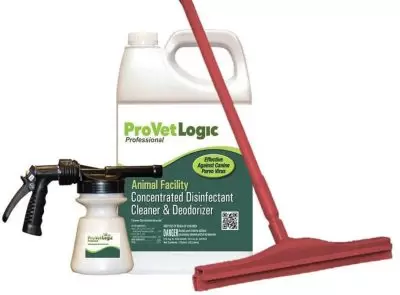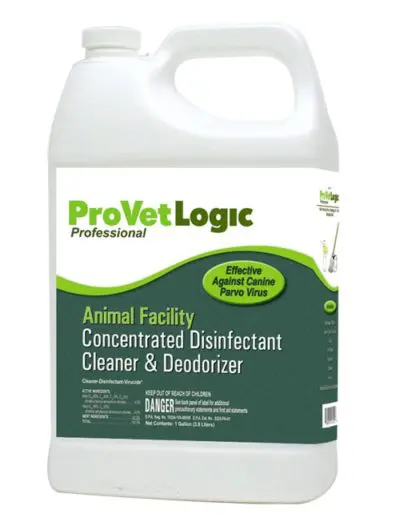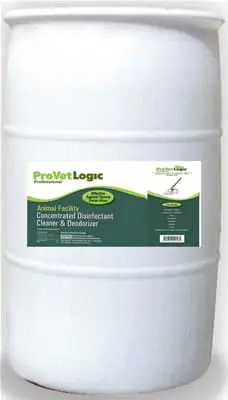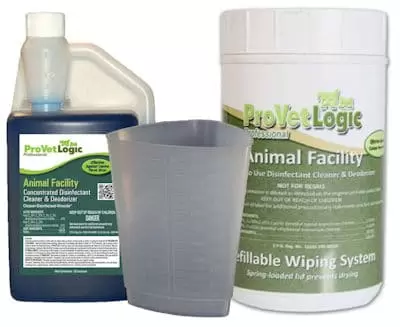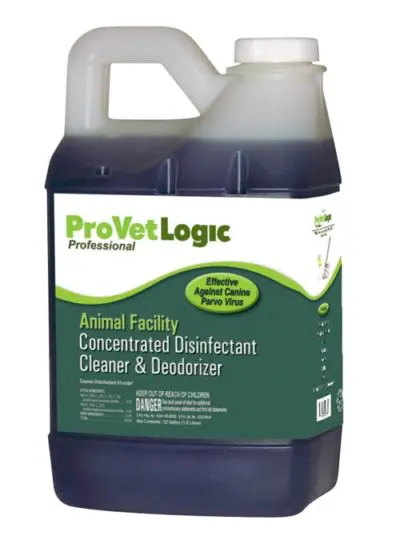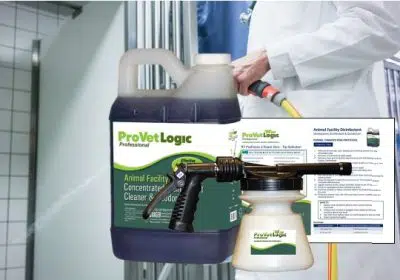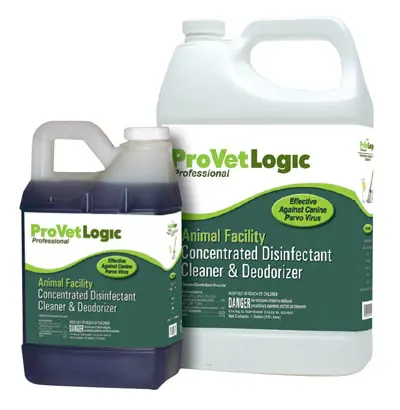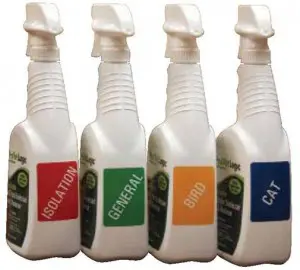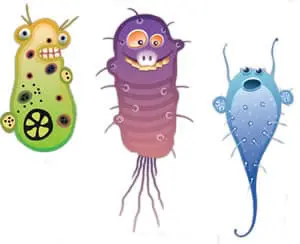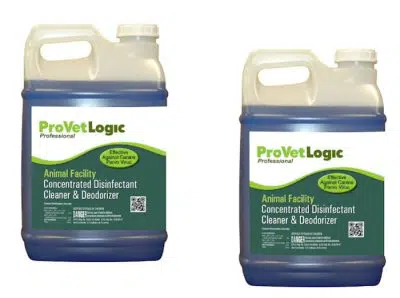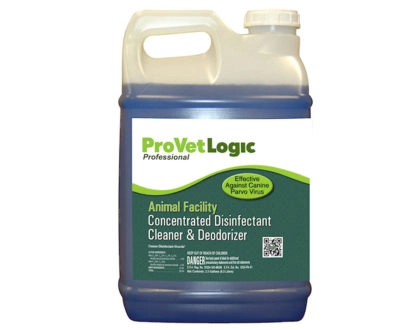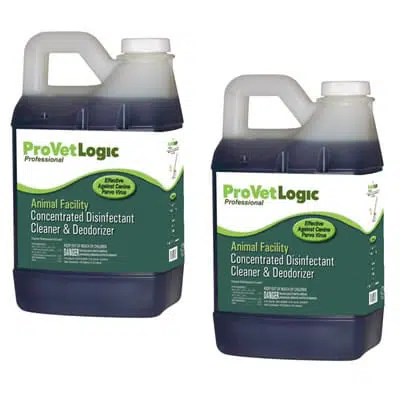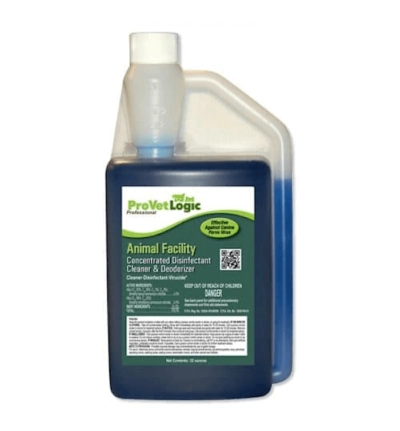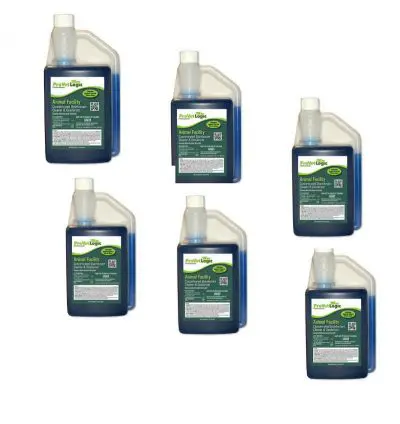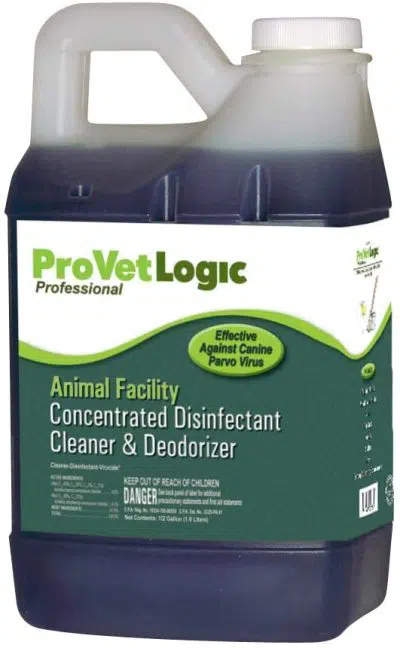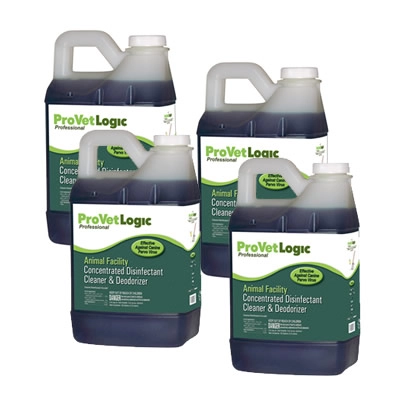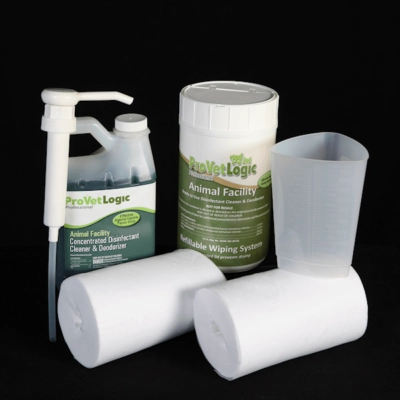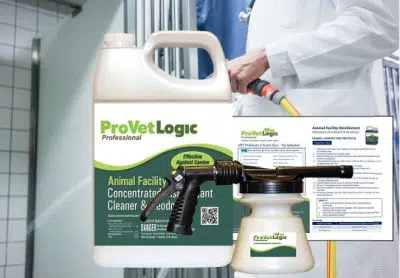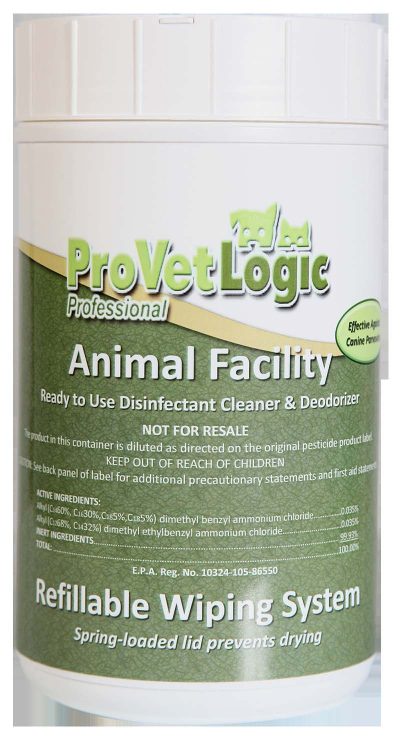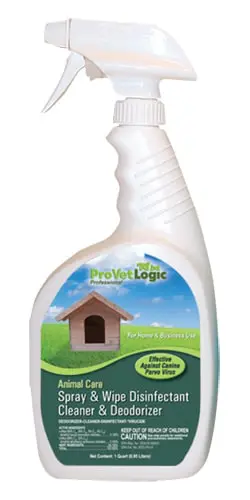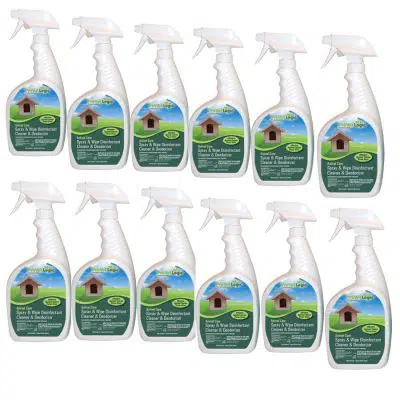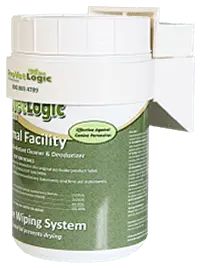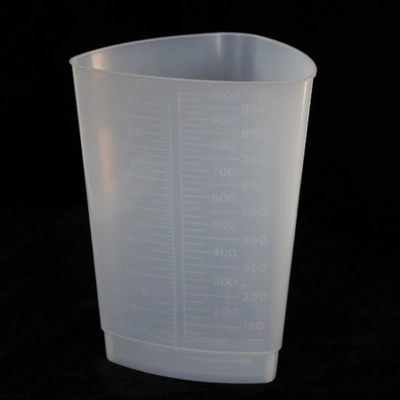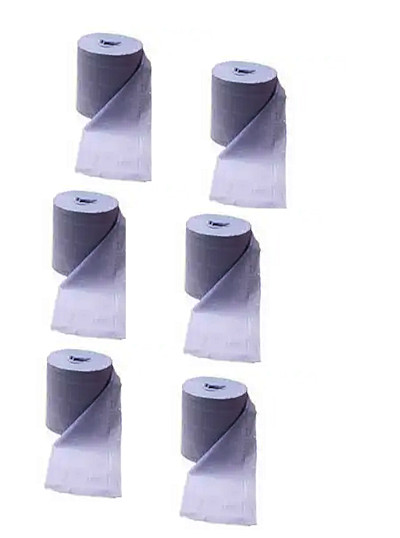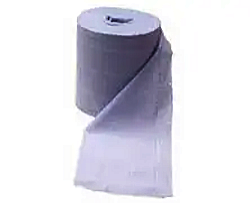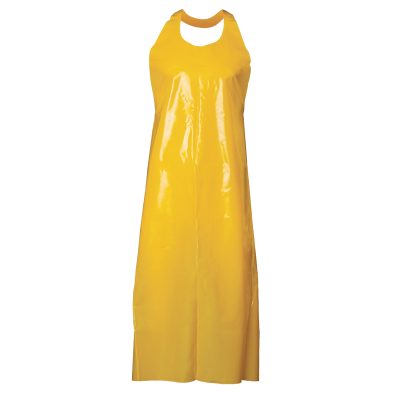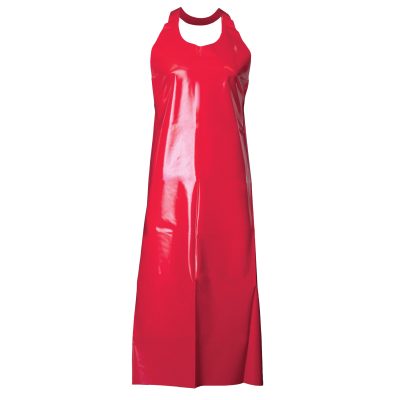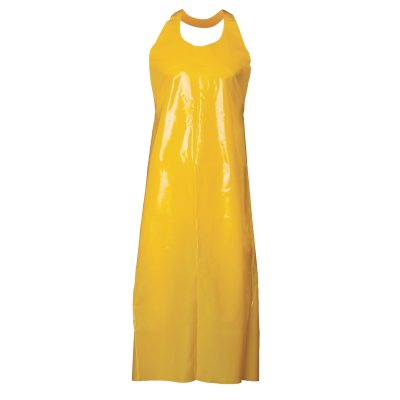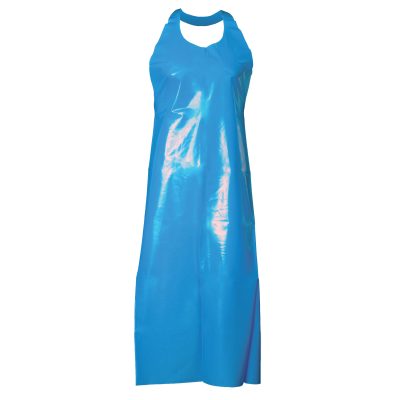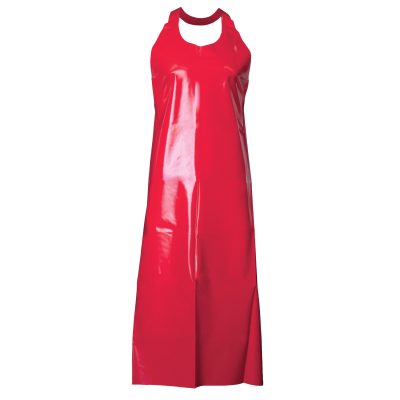WARNING: Do not try this procedure using bleach. Bleach can be absorbed through the paws and will be lethal to cats.
Veterinarian Offices and Animal Shelters
Veterinarians and animal care facilities should purchase One-Gallon containers of Animal Facility. Or, see the full array of products in the disinfectants category.
Homeowners or Small clinics
Homeowners should use the PRE-DILUTED ProVetLogic product “Spray and Wipe.” This is the same effective formula as the concentrated Animal Facility, but in a ready to use spray bottle. It is also handy for examination room cleanings.
Pet Turf Owners
Owners of synthetic pet turf will need to clean the pet turf for odor.
We offer special videos on how to do that.
See Also Visit to The VetGirl.
Large Area Kit
Popular One Gallon Size
Large Area Parvo Treatment
Need to disinfect a large area, such as a kennel run or your yard? Use the combination of the ProVetLogc ProFoam sprayer and Animal Facility Concentrate.
Animal Facility Kit
Use the Animal Facility Kit to replenish disinfectant wipes and save. Here’s a quick video on how to do it.
Convenient Half-Gallon Size
Convenient 4-Packs
Want the precision of metered product use and the convenience of ample supply?
Try the Animal Facility 4-Pack..
ProVetLogic Efficacy Data for Animal Facility Disinfectant Product
Canine
- Bordetella Bronchiseptica (Kennel Cough)
- Canine Parvovirus (CPV) (4 oz. per gallon)
- Canine Adenovirus
- Canine Coronavirus
- Canine Distemper
- Canine Parainfluenza Virus
- Canine Hepatitis
- nfectious Bronchitis Virus
- Rabies Virus
AVIAN
- Avian Influenza A H9N2 / Turkey / Wisiconsin Virus Infectious
- Avian Laryngotracheitis
- Avian Influenza A H5N1 Virus
- Avian Reovirus
FARM
- Equine Arteritis Virus
- Influenza A2/Japan virus
- Minute Virus of Mice (4 oz. per gallon)
- Newcastle disease virus
- Porcine Parvovirus (4 oz. per gallon)
- Porcine Rotavirus
- Pseudorabies virus
- Porcine Respiratory (PRRSV)
- Infectious Bovine Rhinotracheitis
- Transmissible Gastroenteritis (TGE)
FELINE
- Feline Calicivirus
- Feline Calicivirus (surrogate for Norwalk/Norovirus)
- Feline Infectious Peritonitis
- Feline leukemia virus
- Feline Panleukopenia
- Feline Picornavirus
- Feline Rhinotrachetis
OTHER
- Aspergillus niger
- Trichophyton mentagrophytes
- Staphylococcus MRSA
- Escherichia coli
- Salmonella
- Herpes Simplex Type 1 & 2
- HIV-1 (AIDS Virus)
- Human Corona Virus
- Influenza A/Hong Kong
- Hepatitis B & C
- Vaccinia Virus
- Murine Parainfluenza Virus Type 1
Learn How To Kill Canine Parvovirus from the Efficacy Data ReportAnimal Care Spray & Wipe Disinfectant Cleaner Efficacy Data
Ready-To-Use Disinfectant, Cleaner & Deodorizer
Bleach Doesn’t Work
Need to see why this is so much better than bleach? Read our report.
Looking for a way to keep the economics of dilution and reduce the labor costs at the same time? Look to the right.
Complete Array of Disinfecting Solutions for Animal Shelters, Veterinarian Offices, Hotels and Hospitals.
-
Animal Facility Disinfectant – 1 Gallon
$47.79 -
Animal Facility Disinfectant – (4) 1 gallon Bottles
$180.42 -
Animal Facility Disinfectant 2.5 Gallon Bottles
$221.43 -
Animal Facility Disinfectant 2.5 Gallons
$123.00 -
Animal Facility Disinfectant 2Pack
$52.58 -
Animal Facility Disinfectant 55 Gallon Drum
$1,708.59 -
Animal Facility Disinfectant AcuPro Bottle 32 Ounce
$19.95 -
Animal Facility Disinfectant AcuPro Bottle 32 Ounce – 6 Pack
$67.26 -
Animal Facility Disinfectant Cleaner- 1/2 Gallon
$29.21 -
Animal Facility Disinfectant Half Gallon ProLoc Bottle
$29.34 -
Animal Facility Disinfectant Kennel Sanitizing Kit
$211.62 -
Animal Facility Disinfectant Kennel Sanitizing Kit
$130.75 -
Animal Facility Disinfectant ProLoc Bottles– 4 Pack
$105.64 -
Animal Facility Disinfectant Refillable Wiping Starter Kit
$99.00 -
Animal Facility Disinfectant Sanitizing Kit -One Gallon
$159.95 -
Animal Facility Refillable Wiping System
$19.50 -
Animal Facility Refillable Wiping System 6-Pack
$111.15 -
ProVetLogic Professional Animal Care Spray & Wipe Disinfectant Cleaner & Deodorizer
$19.95 -
ProVetLogic Spray & Wipe Disinfectant 32 Ounce – 12 Pack
$113.30 -
Refillable Animal Facility Disinfectant AcuPro Kit
$39.95 -
Refillable Wiping System Canister Bracket
$25.00 -
Refillable Wiping System Measuring Cup – 32 Ounces
$1.95 -
Refillable Wiping System Replacement Rolls-6 Pack
$89.30 -
Refillable Wiping System Replacement Towel Roll (Single)
$15.67 -
Top Dog Aprons – Die Cut 50 Inch 6 Mil – White
$17.65 -
Top Dog Aprons – Die Cut 50 Inch 6 Mil – Yellow
$17.65 -
Top Dog Aprons -Die Cut 45 Inches 6 Mil – Green
$16.33 -
Top Dog Aprons -Die Cut 50 Inch 6 Mil – Red
$17.65 -
Top Dog Aprons 45 Inch Die Cut – 6Mil -Yellow
$16.33 -
Top Dog Aprons 45 Inch Die Cut 6 Mil White
$16.33 -
Top Dog Aprons 45 Inch Die Cut 6Mil Blue
$16.33 -
Top Dog Aprons 45 Inch Die Cut 6Mil Red
$16.33


